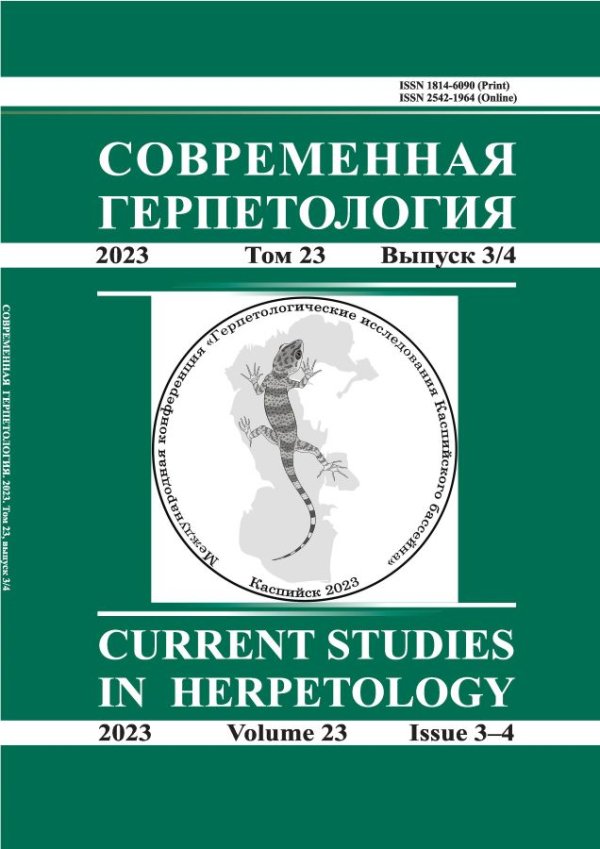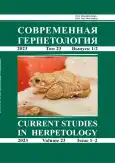Vol 23, No 1-2 (2023)
Articles
Reproductive ecology of Anuran Amphibians: Effects of internal and external factors
Abstract
This research paper examines the influence of internal factors (female body weight, body condition) and external ecological factors on the reproductive parameters of females, as well as on the reproductive ecology of adult individuals of anuran amphibians. Among the most significant reproductive characteristics of females are the number of eggs in a clutch, the proportion of reproductive products to female body weight (contribution to reproduction), and the average weight of eggs. The body weight of the female and the ecological (meteorological) conditions of her activity during the year preceding spawning, as well as the hibernation conditions, have the greatest impact on the quantitative expression of these parameters. The proportion of reproductive products to female body weight in anuran amphibians usually ranges from 13 to 30%. Climate warming can directly affect the reproductive parameters of females, the survival of metamorphs, and the phenology of the spawning period.
 3-26
3-26


On the problem of specific identification in triploid (Bufotes baturae) and tetraploid (B. pewzowi) green toads (Amphibia, Anura, Bufonidae) of Central Asia by morphometric characteristics
Abstract
The paper presents the results of using multiplicative indices for species identification of polyploid green toads of Central Asia. Live adult individuals of Bufotes baturae (24 females and 17 males) from the territory of Tajikistan and B. pewzowi (14 females and 24 males) from Kazakhstan, Uzbekistan and Tajikistan were studied. The animals were caught in nature, measured and immediately released. The species belonging of the studied green toads was established by cytogenetic methods. According to the results of discriminant analysis, six proportionality indices were significant for the species identification of females. The females of B. batura and B. pewzowi formed separate non-overlapping clusters in the discriminant function space, and the level of their reliable classification was 100%. For the identification of B. batura and B. pewzowi males, four significant body proportionality indices were identified using discriminant analysis. The clusters of these two species in the space of discriminant function touched, and the level of correct classification was 97.6%. As a result of our research, one multiplicative index common to males and females was identified for highly reliable identification of B. baturae and B. pewzowi, as well as one multiplicative index separately for males and females of the studied species. The authors conclude that multiplicative indices based on standard morphometric indicators can be used for the practical determination of polyploid green toads.
 27-35
27-35


Current state of internet trading of sea turtle (Cheloniidae) derivatives in Russia
Abstract
This paper reports the results of our monitoring the presence of advertisements for the sale of sea turtle (Cheloniidae) derivatives on the Internet in Russia in 2021 and 2023. Data on species, number, region of origin, market price and turnover rate of these derivatives are summarized. A brief analysis of the regulatory framework governing the turnover of sea turtle derivatives is given and the conclusion on the necessity of its adjustment is provided.
 36-43
36-43


Age differences in the leukocyte blood composition of the common viper Vipera berus (Reptilia: Serpentes: Viperidae)
Abstract
The results of our comparative analysis of parameters of the leukocyte blood system of underyearlings and mature specimens of the common viper Vipera berus are presented. The material was the blood of 36 females and 26 males caught in the Middle Volga basin, and 13 underyearlings born in captivity from 4 females of this sample. V. b. berus underyearlings differed: from the females by a lower content of heterophils and azurophils, an increased content of eosinophils and basophils, an increase in the leukocyte shift index, a decrease in the lymphocytic–granulocytic index, the index of the of heterophil–eosinophil ratio, the index of the lymphocyte–eosinophil ratio; from the males by a reduced content of heterophils, an increased content of eosinophils and basophils, an increase in the leukocyte shift index, the index of the heterophil–eosinophil ratio, and the index of the lymphocyte–eosinophil ratio. In general, the adaptive response of the blood system of underyearlings indicated the later activation of lymphocytes as an effector link and the imbalance of the immune response due to the lack of a resource of immunocompetent cells (agranulocytes) compared with the indices of adults from natural populations.
 44-51
44-51


Short Communications
New findings of the Caucasian toad (Bufo verrucosissimus, Amphibia, Anura, Bufonidae) in the Kuma River basin (North Caucasus, Russia)
Abstract
The paper discusses the distribution of Bufo verrucosissimus in the North Caucasus. It is noted that the absolute majority of findings of this species in Russia have occurred in the Black Sea basin. All currently known habitats of B. verrucosissimus in the Caspian basin are located in the upper part of the Kuma River basin (the vicinity of Kislovodsk town and Borgustanskaya village in the Stavropol region). New points of findings are shown between the mouths of the Ugol’naya and Kladbishchenskaya Balka rivers (left tributaries of the Kuma River), as well as near Bekeshevskoye Lake (Predgorniy district, Stavropol region). The authors believe that B. verrucosissimus may be distributed along the gallery forests of the Kuma River up to Georgievsk town and Soldato-Alexandrovskoye village.
 52-57
52-57


Captive breeding of Regel’s racerunner (Eremias regeli, Reptilia, Lacertidae)
Abstract
The paper presents the results of laboratory reproduction of Regel’s racerunner (Eremias regeli). Offspring was obtained from natural individuals (2 females and 2 males) captured in the vicinity of the Bokhtar town (Khatlon region, Republic of Tajikistan). Captive-born animals (3 females and 2 males) began laying eggs at the age of 7 months. The lizards from nature reproduced twice a year, while the animals obtained in the laboratory lay eggs up to three times per season. The clutches of both natural and laboratory lizards contained from 2 to 4 eggs. In total, 9 fertile clutches and 26 eggs were studied, which 18 newborn lizards were obtained from. The mass of one clutch ranged from 28.97 to 54.68% of the female mass. The eggs had a length of 12.3–18.1 mm, a width of 7.3–9.4 mm and a weight of 0.53–0.95 g. Incubation lasted 56–99 days. The newborn lizards had a body length of 26.5–35.1 mm, a tail length of 41.1–60.0 mm and a mass of 0.60–1.11 g. Comparing the reproductive parameters of E. regeli with other representatives of the tribus Eremiadini, the authors note relatively small sizes of adult females, their low fertility, but large sizes of eggs and newborn juveniles.
 58-64
58-64


Introduction and reintroduction of the takyr roundhead Phrynocephalus helioscopus (Agamidae, Reptilia) in the Altai region
Abstract
Information is provided on the introduction and reintroduction of the takyr roundhead (Phrynocephalus helioscopus) in the Altai region under the “Program of Comprehensive Study of the Methods of Keeping and Breeding in Captivity of the Takyr roundhead (Phrynocephalus helioscopus)”.
 65-68
65-68


Chronicles
International Scientific Conference “Zoological Research in Kazakhstan in the XXI Century: Results, Problems and Prospects” (Republic of Kazakhstan, Almaty, April 13 – 16, 2023)
 69-71
69-71


Jubilees
Larisa A. Kupriyanova
 72-73
72-73












